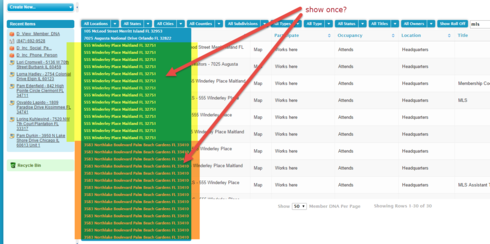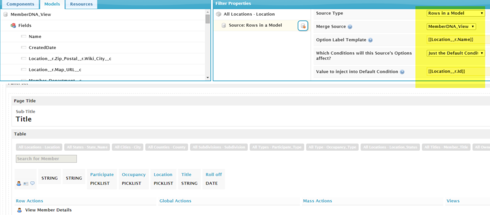I have a filter that lists the same item multiple time. I would like to have each item show once without coding. 
What is the source for the filter? Looks like a model which is looking up the locations on a related object. ie. Contact object while looking at Account address.
That is correcct
That is what I thought.
Change your source of locations to the related object model instead of the model in the table.
The data in this list that is from the parent table as well as 3 related tables. The only way I know to expose all the fields is by drilling down thru the parent table. Thoughts? 
Quick documentation plug here: Cheat Sheet of Filter Use Cases. I think this is case 7 (Filter based on a junction object membership), but it may also be achievable with use case 6 (Filter based on a string field).
By chance, is there a youtube video of this being done?
I don’t think there is a video that lays out this particular use case. Here is a video about complex filter scenarios, but I don’t think it covers what you are trying to do. But the document J pointed you to above has the detail. I think use case 6 is what you need to look at.
I think there is a far simpler solution. Because City is a reference field. Can you not use an automatic filter and just choose the City reference field? Automatic filters do not require you to set up conditions, and handle the uniqueness problem you originally asked about. In addition - if you need to filter on grandparent data (the owner of accounts above the opportunity list you are on), automatic filters will handle this as well.
I have tried 6. Filter based on a string
https://drive.google.com/file/d/0B409lhd9sYDcenhteWpDai1vNFU/view?usp=sharing
still does not work. See Link above
I see two things in your video that may be wrong with the aggregate model you are using as the source for your filter.
1. If you want your data to be sorted, you need to add a field. Just putting “DESC” will not work. In fact, I’m pretty sure that the big red error is related to that issue. I’d start by taking all sorting out, and get that to work first. Then add sort order back.
2. If your grouping field (city) is a relationship field (pulled from a list of possible cities) rather than just a free form string field, you can not just use the referred Object Id in your aggregate model. This is an issue we need to correct in Skuid. You need to go through the relationship and get the actual Name field of the object you want. I can’t really tell from your video which this is.
Hopefully these ideas solve your problem.
Ok. I took out the the DESC and added the field name. The field names are now showing. However, they are not summarized. Oldsmar shows up twice.
https://docs.google.com/file/d/0B409lhd9sYDcZGxRZ1dlOVRRVzA/edit
Because you are going through so many objects, your aggregate is pulling duplicate values. If you make your aggregate model on the Zip Postal object, or make a normal model on the City object you can achieve the uniqueness you are looking for. You can add conditions in either case so that only City records that are associated with the Member_DNA records shown will be in the model (And therefore in your drop down).
What is the most efficient method? I have filters on City, State, Zip and County all in the path: Member_DNA__c>Location__r>Zip_Postal__r. It does not seem the level should matter. I have filters like in almost all page where I am looking at name in a child record. Once I have this working, then I can correct in all my pages. Can we do a screen share or I can give you access.
Yup, give us access and I’ll take a look. Send me an email with the page name and steps to reproduce the issue.
Great. You have access. The page is:
https://dorothy–skuid.na16.visual.force.com/apex/UI?page=D_View_Member_DNA
In the “search for member” on right type “Whita” that will present the city selector.
I might suggest recording a small video of what you do and start creating a collection of methods for customer reference. Sometimes a picture/video is better than words.
I missed a key issue in your first video. And that is the problem with this stuff. There is one way it works, and dozens of ways it can go wrong…
In your Filter Source defintion, you had not changed the “Merge Source” property to the new model (City Grouping). 
I have changed the property and your filter now works. You will need to create the same structure of aggregate models as the model source for your other filters.
I just changed that name after we talked. It just went out to try and it 
still does not work.
I think what you are trying to do is not possible. It looks like you want to put a term in the search box, and then for all the filters to respond to that search term and only show cities (or states or counties or…) that are contained in that subset of records. To get unique values in your drop downs, your filter source has to come from another model, which is not filtered automatically to the records currently in the large table.
In the image above, if you start typing Naper…, you will see Naperville in the filter. But if you type Park Ridge you also see it, and the combination of a query for “Park Ridge” and “Whita” will likely not produce any results.
Here is the difference between city and state fields filters. https://docs.google.com/file/d/0B409lhd9sYDcN3NRdzJuSGVKMzA/edit?pli=1
Yup. Your city filter source and condition were connected to different fields. The condition was looking for the City__c (which is the ID field), and the filter source was passing it the City Name field. They would never match. I’ve put them both to the City Name field and it works.
Yup. City works. Explain again why does the City field not turn into a drop down when the list is less than 100 records?
https://docs.google.com/file/d/0B409lhd9sYDcZU5udzl0Wmk3V1E/edit?pli=1
Reply
Enter your E-mail address. We'll send you an e-mail with instructions to reset your password.

